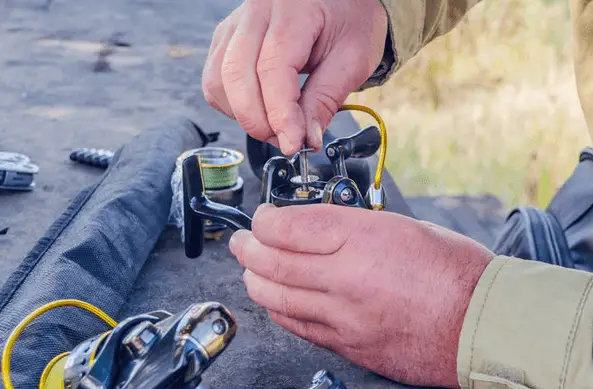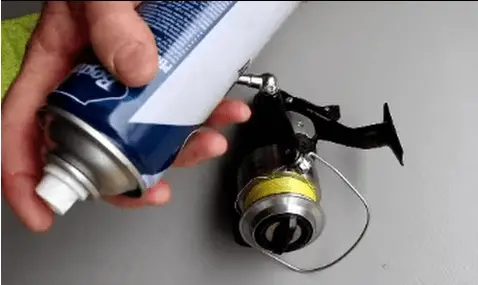To clean a fishing reel, disassemble it, remove dirt and debris, use a lubricant, and reassemble it carefully. Taking good care of your fishing reel is essential for its longevity and optimal performance.
Proper maintenance includes regular cleaning to remove dirt, debris, and saltwater residue. Cleaning a fishing reel is a straightforward process that can be done at home with a few basic tools. By following a few simple steps, you can keep your fishing reel in top shape, ensuring smooth operation and prolonging its lifespan.
This article will provide a step-by-step guide on how to clean a fishing reel effectively, so you can enjoy your fishing trips without any issues. Let’s dive in and learn the proper way to maintain your fishing reel.
Gathering The Supplies
Before you begin cleaning your fishing reel, it is important to gather all the necessary supplies. Having everything you need within reach will ensure a smooth and efficient cleaning process. Here is a checklist of supplies you will need:
Checklist Of Supplies
To clean your fishing reel properly, you will need the following items:
- A soft, clean cloth or towel
- A small, clean brush with soft bristles
- A toothpick or cotton swabs
- Isopropyl alcohol or a reel cleaning solution
- A small container to hold the cleaning solution
- Q-tips or pipe cleaners
- A screwdriver or a multi-tool
- A reel grease or lubricant specifically designed for fishing reels
- Paper towels or a lint-free cloth
Choosing The Right Cleaning Solution
When it comes to choosing the right cleaning solution for your fishing reel, there are a few options to consider. It is crucial to use a solution specifically designed for cleaning fishing reels to avoid damaging the reel or its components. Here are some key points to keep in mind:
1. Look for a cleaning solution that is recommended by the reel manufacturer or reputable fishing experts.
2. Consider using isopropyl alcohol as a cleaning solution if a reel-specific product is not available. Ensure the alcohol is at least 90% concentration.
3. Avoid using harsh chemicals or solvents, as they can cause corrosion or damage to the reel.
4. Remember to read the instructions on the cleaning solution carefully before use.
By choosing the right cleaning solution, you will ensure that your fishing reel is effectively cleaned without any negative side effects.
Disassembling The Reel
Learn how to clean your fishing reel by disassembling it step by step. Keep your reel in top condition for optimal performance on your next fishing trip.
Removing The Spool
To clean a fishing reel thoroughly, it is essential to disassemble it properly. This disassembly process allows you to access all the nooks and crannies where dirt, grit, and debris may have accumulated over time. The first step in disassembling a reel is removing the spool.
Follow these steps to safely remove the spool:
1. Locate the drag adjustment knob on the front of the reel. Rotate it counterclockwise to loosen the drag.
2. Once the drag is loose, hold the spool tightly with one hand.
3. Use your other hand to turn the handle clockwise. This action should release the spool from the reel body.
4. Gently pull the spool away from the reel body. Be careful not to force it or pull too hard, as this may cause damage.
By following these simple steps, you can remove the spool from your fishing reel without any hassle. Now that the spool is safely taken off, let’s move on to the next step in disassembling the reel.
Taking Apart The Handle
The handle of a fishing reel is another component that needs to be disassembled for a thorough cleaning. Dirt and saltwater residue can accumulate on the handle, affecting its performance and lifespan. Here’s how you can dismantle the handle:
1. Locate the screw or nut that secures the handle to the reel body. It is usually situated at the base of the handle.
2. Use the appropriate screwdriver or wrench to loosen and remove the screw or nut.
3. Once the fastening mechanism is removed, gently lift the handle away from the reel body.
Remember to keep track of any small parts like washers or spacers that may come loose during the process. Storing them in a clean container will help avoid losing them. Now that the handle is disassembled, we can move on to the final step in disassembling the reel.
Dismantling The Gear System
The gear system is the heart of a fishing reel, and it is crucial to clean it thoroughly. Over time, dirt, debris, and fishing line residue can accumulate in the gear system, affecting its smooth operation. Follow these steps to dismantle the gear system:
1. Locate the screws or fastening mechanism that holds the side plate in place.
2. Using the appropriate screwdriver, carefully loosen and remove the screws.
3. Once the side plate is removed, you will have access to the gears and other internal components.
4. Gently lift the gears and any other movable parts away from the reel body.
Take note of the order and arrangement of the gears and other components as you remove them. This will make reassembling the reel much easier later on. With the gear system dismantled, you can now proceed with cleaning each individual part for optimal performance.
Cleaning The Reel Components
When it comes to maintaining your fishing reel, cleaning the reel components is an essential task that will keep it performing at its best. Cleaning the spool, cleansing the handle, and degreasing the gear system are key steps in the maintenance process. In this section, we will dive into the details of each component and provide you with a step-by-step guide on how to clean them properly.
Cleaning The Spool
The spool is one of the most critical components of your fishing reel as it holds the fishing line. Over time, dirt, debris, and even fishing line residue can accumulate on the spool, causing friction and potentially affecting your casting performance. To ensure smooth operation, follow these steps to clean the spool:
1. First, remove the spool from the reel by loosening the drag knob or releasing the spool release button, depending on your reel model.
2. Inspect the spool for any visible dirt or debris. Use a soft cloth or cotton swab to remove any loose particles.
3. If the spool is heavily soiled, you can rinse it gently under lukewarm running water. Be careful not to use high-pressure water, as it may damage the internal components of the reel.
4. Dry the spool thoroughly using a clean cloth or towel.
5. Apply a small amount of reel oil to the spool bearings and any other moving parts. This will help lubricate the components and prevent corrosion.
6. Lastly, reattach the spool to the reel and tighten the drag knob or engage the spool release button. Make sure it is securely fastened.
Cleansing The Handle
The handle of your fishing reel is subjected to constant use and exposure to various elements, making it susceptible to dirt, saltwater, and grime buildup. Cleaning the handle regularly will keep it functioning smoothly. Here’s how to do it:
1. Begin by loosening the handle screw or bolt to detach it from the reel body. Use the appropriate screwdriver or tool for this step.
2. Inspect the handle for any visible dirt or corrosion. Wipe it down with a damp cloth to remove any loose particles.
3. If the handle is heavily soiled, you can use a mild soap solution to cleanse it. Apply the solution using a soft brush or cloth, then rinse it thoroughly with clean water.
4. Dry the handle completely before reattaching it to the reel.
5. Apply a small amount of reel oil to the handle bearings and the connection points to ensure smooth rotation and prevent rust.
6. Finally, secure the handle back onto the reel body and tighten the screw or bolt until it is snug.
Degreasing The Gear System
The gear system of a fishing reel is responsible for transferring power from the handle to the spool, enabling precise line retrieval. Over time, grease and debris can accumulate in the gears, affecting their performance. Follow these steps to effectively degrease the gear system:
1. Start by opening the reel cover or removing the side plate to access the gear system. Refer to your reel’s manual or manufacturer guidelines for the specific steps.
2. Inspect the gears for any visible dirt, old grease, or debris. Use a soft brush or toothbrush to gently remove any buildup.
3. Apply a reel degreaser or isopropyl alcohol to a clean cloth or cotton swab, and carefully wipe the gears to remove any remaining grease.
4. Ensure the gears are dry before applying a thin layer of reel lubricant. This will help reduce friction and protect against rust.
5. Once the lubricant is applied, reassemble the reel cover or side plate.
Following these steps and regularly cleaning your fishing reel’s components, you can extend its lifespan and maintain its optimal performance. Remember to always refer to your reel’s manual or manufacturer guidelines for specific cleaning instructions and product recommendations.
Inspecting And Lubricating
Inspecting and lubricating your fishing reel is essential for maintaining its performance and longevity. Regular cleaning and lubrication help prevent rust, corrosion, and wear and tear, ensuring that your reel operates smoothly and effectively. In this section, we will discuss how to inspect your reel for damage, oil or grease the bearings, and apply lubricants to moving parts.
Inspecting For Damage
Before lubricating your fishing reel, it’s important to inspect it for any signs of damage. This will help you identify any issues that may affect its performance. Here are a few simple steps to follow:
1. Check the reel body for cracks, dents, or misalignments.
2. Inspect the handle, bail arm, and drag system for any signs of wear or damage.
3. Examine the line roller, bail wire, and spool for corrosion or rust.
4. Ensure that the drag system engages smoothly without any skips or slips.
Oil Or Grease The Bearings
The bearings in your fishing reel play a crucial role in keeping it running smoothly. To keep them functioning properly, you’ll need to oil or grease them. Here’s how to do it:
1. Identify the bearings in your reel. They are usually located inside the handle, spool, and bail assembly.
2. If your reel has shielded bearings, remove the shields carefully using a small screwdriver.
3. Apply a drop of fishing reel oil or a small amount of reel grease to each bearing.
4. Rotate the bearings gently to ensure the lubricant spreads evenly.
5. Replace the shields if you removed them.
Applying Lubricants To Moving Parts
In addition to lubricating the bearings, it’s important to apply lubricants to other moving parts of your fishing reel. This will help reduce friction and ensure smooth operation. Follow these steps to apply lubricants:
1. Identify the moving parts that require lubrication, such as the gears, spool shaft, and bail arm.
2. Use a thin layer of fishing reel oil or grease to coat these parts, ensuring that you cover all the surfaces.
3. Rotate the gears or move the bail arm back and forth to distribute the lubricant evenly.
4. Wipe off any excess oil or grease using a clean cloth.
By inspecting and lubricating your fishing reel regularly, you can ensure its optimal performance and extend its lifespan. Remember to always use the appropriate lubricants recommended by the manufacturer and follow their instructions for maintenance. Taking care of your fishing reel will not only enhance your fishing experience, but it will also protect your investment in the long run.
Reassembling And Storage
Learn how to effectively clean a fishing reel, ensuring its optimal performance and longevity. Discover step-by-step instructions for disassembling and reassembling your reel, along with proper storage techniques. Increase the lifespan of your reel and enhance your fishing experience with these expert tips.
Putting The Reel Back Together
Reassembling your fishing reel is just as important as cleaning it. Follow these simple steps to ensure you put everything back where it belongs:
1. Start by positioning the spool back onto the reel frame. Make sure it fits snugly and aligns properly.
2. Reattach the drag knob and handle, ensuring they are securely tightened. These components are essential for smooth operation.
3. Next, apply a small amount of reel oil to the gears, bearings, and other moving parts. This will help reduce friction and prolong the life of your reel.
4. Once oiled, carefully slide the side plate back into place. Take your time to ensure it lines up correctly with the reel frame.
5. Use the screws or bolts that you had removed earlier to secure the side plate. Tighten them just enough, being careful not to overtighten and strip the threads.
Storing The Cleaned Reel
Now that your fishing reel is clean and reassembled, it’s important to store it properly to prevent any damage and maintain its functionality. Here are a few tips for storing your reel: – Store the reel in a cool and dry place, away from direct sunlight and extreme temperatures. This will help prevent the growth of mold and corrosion. – Avoid storing the reel in a damp or humid environment, as this can damage the internal components and lead to rust. – If possible, keep the reel in its original box or a padded reel case to protect it from any potential knocks or bumps.
Before storing, make sure the reel is completely dry to prevent any moisture from causing damage over time. – If you have multiple fishing reels, store them individually and avoid stacking them on top of each other to prevent any unnecessary pressure or strain. By following these simple steps for reassembling and storing your cleaned fishing reel, you can ensure that it stays in great condition and performs at its best for your next fishing adventure. Take the time to properly maintain your reel, and it will reward you with years of reliable use. Happy fishing!
Frequently Asked Questions For How To Clean A Fishing Reel
What Tools Do You Need To Clean A Fishing Reel?
To clean a fishing reel, you will need a few essential tools: a soft cloth or sponge, a small brush or toothbrush, mild soap or reel cleaning solution, reel grease or oil, and a screwdriver (if necessary for disassembling the reel).
Can I Use Water To Clean A Fishing Reel?
Yes, you can use water to clean a fishing reel. However, it is important to avoid applying excessive water pressure or immersing the reel entirely, as this can cause damage. Use a soft cloth or sponge dampened with water to wipe away dirt and grime gently.
Last Word
Properly maintaining your fishing reel is essential for its longevity and optimal performance. By following the step-by-step guide we’ve provided, you can effectively clean your reel and ensure it stays in great condition. Regular maintenance will prevent corrosion and prolong the lifespan of your reel, enabling you to enjoy successful fishing trips for years to come.
Remember to use the right tools and products as mentioned in the guide, and always pay attention to the manufacturer’s instructions. Happy fishing and good luck!



